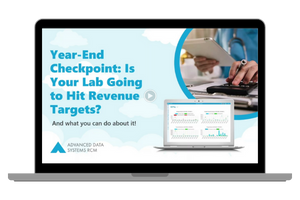Is Your Lab on Track to Hit Its 2025 Revenue Targets?
A Year That’s Testing Every Lab’s Financial Model
Halfway through 2025, many diagnostic and clinical laboratories are facing a strange paradox. Test volumes remain healthy—or even rising—yet revenue is trending downward. This gap isn’t just frustrating; it’s a warning sign that familiar revenue-cycle levers no longer work in today’s reimbursement environment.
Across ADS client data, we’re seeing year-over-year revenue declines of 7–12 percent, even in labs with solid payer relationships and efficient billing teams. The cause isn’t a single event; it’s a combination of payer compression, outdated contracts, AI-based audits, and workflow inefficiencies that silently drain financial performance.
For labs that depend on predictable reimbursements to fund operations, staffing, and growth, these issues can snowball quickly. The last quarter of 2025 will determine which labs enter 2026 in control—and which are caught in a cycle of denials and shrinking margins.
The Real Cost of Revenue Leaks
Every lab leader has heard that “denials are expensive,” but few quantify how much.Based on MGMA and ADS analysis, each 1 percent increase in denials translates to roughly $24,000 in annualized loss for every 50,000 claims.
Those dollars don’t just disappear once—they compound through delayed cash flow, write-offs, and rework.
Three categories account for most hidden losses:
- Medical-necessity and coding mismatches. AI audit engines now flag incomplete documentation or unsupported ICD progressions before a claim even reaches review.
- Prior authorization gaps. When orders flow in without verified coverage or payer criteria, downstream teams absorb the fallout.
- Contract misalignment. Contracts older than 18 months rarely reflect current market rates, leaving 3–7 percent of potential reimbursement uncollected.
When stacked across multiple payers and thousands of monthly claims, these “invisible” leaks can outsize any productivity gain.
Why More Tests Won’t Solve It
The reflex for many organizations is to push for higher test volume—more samples, more throughput, more clients. But volume no longer guarantees growth.
In 2025, payer algorithms are designed to detect anomalies before adjudication, and automation has shifted leverage away from labs that rely on brute-force billing fixes.
Revenue growth now depends on precision, not production. That means focusing on pre-analytic data integrity, payer-mapping accuracy, and digital claims readiness—long before invoices go out.
Labs that embrace this shift are already seeing faster reimbursements and higher first-pass acceptance rates, even as competitors stagnate.
How to Tell if Your Lab Is Off-Track
The warning signs usually appear in subtle operational metrics:
- Days in A/R creeping above 40. Cash-flow lag is one of the earliest indicators of systemic friction.
- Denial rate trending upward by 1–2 points over consecutive quarters.
- Inconsistent reporting across LIS, EHR, and billing systems, leading to mismatched CPT volumes.
- Staff fatigue from manual reconciliation or repeated payer follow-ups.
If these patterns sound familiar, your lab likely has the same underlying issue we see across the industry: fragmented financial visibility.
Turning Data Into Action: The ADS Framework
At ADS, our revenue-resilience model focuses on three pillars that consistently help labs regain control:
- Revenue Intelligence. Go beyond dashboards to identify where—and why—money is being lost.
- Workflow Automation. Digitally map claims from order entry through payment posting, eliminating redundant human steps.
- Contract Optimization. Simulate reimbursement under new payer fee schedules to renegotiate before renewal.
Implementing even one pillar typically boosts clean-claim rates by 4–6 percent within 90 days.
The 90-Day Roadmap to Year-End Recovery
A focused quarter is all it takes to close major revenue gaps.
Start with an internal diagnostic:
- Step 1: Audit denial categories and rank by financial impact.
- Step 2: Validate CPT and payer mappings against current fee schedules.
- Step 3: Review outstanding contracts for renewal timing and outdated rate clauses.
- Step 4: Automate repetitive billing tasks to free staff for root-cause analysis.
- Step 5: Re-forecast revenue targets using corrected reimbursement data.
Labs that complete this process by early Q4 not only recover lost revenue but enter 2026 with stronger compliance and forecasting discipline.
Watch the Briefing: The State of Lab Revenue 2026

ADS experts Christina Rosario and Jim O’Neil have created a concise, on-demand visual briefing to help labs navigate the dual pressures of PAMA 2026 and CLIA modernization.
In just a few minutes, you’ll see:
- How upcoming reimbursement cuts could impact your most common CPT codes
- How to verify payer data and prevent locked-in underpayments
- How automation and smarter analytics can strengthen compliance and cash flow
- The KPIs that signal true financial precision in a shifting revenue landscape
It’s not a webinar — it’s a visual, data-rich experience designed for
busy lab leaders who want clarity without the noise.
The Bottom Line
The next six months will define your lab’s next three years of reimbursement.
Waiting until 2026 to adapt will lock in losses that can’t be recovered.
By watching the briefing, auditing your payer data, and leveraging ADS’s Lab Health Check, your team can turn regulatory pressure into a strategic advantage.
Start now. Get compliant. Protect every dollar you’ve earned.
About Jim O'Neill
As the company’s Laboratory Services Business Development Manager, Jim has 30 years’ experience in LIS and financial systems including 20 years as the owner of CSS (Avalon LIS). With a Bachelor’s degree in information technology from Rowan University, Jim has worked / consulted with over 500 labs in the US and internationally in improving their LIS and financial solutions. Jim is genuinely people-oriented and civic-minded; he’s the former Mayor of Northfield NJ and is currently on the town’s council.


